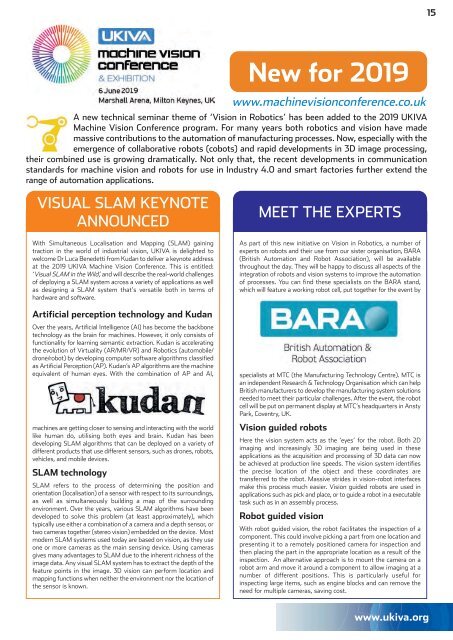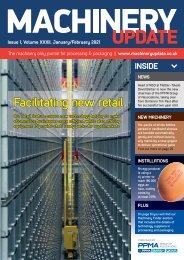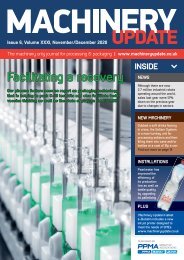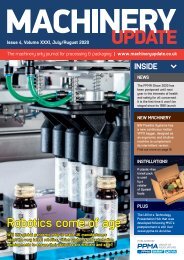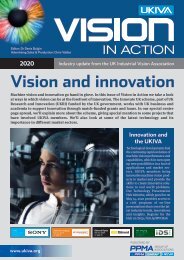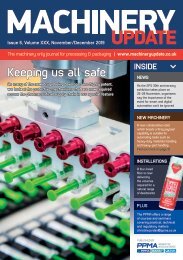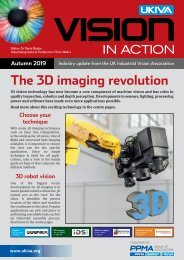VIA Spring 2019 On-Line NEW
- No tags were found...
You also want an ePaper? Increase the reach of your titles
YUMPU automatically turns print PDFs into web optimized ePapers that Google loves.
15<br />
New for <strong>2019</strong><br />
www.machinevisionconference.co.uk<br />
A new technical seminar theme of ‘Vision in Robotics’ has been added to the <strong>2019</strong> UKIVA<br />
Machine Vision Conference program. For many years both robotics and vision have made<br />
massive contributions to the automation of manufacturing processes. Now, especially with the<br />
emergence of collaborative robots (cobots) and rapid developments in 3D image processing,<br />
their combined use is growing dramatically. Not only that, the recent developments in communication<br />
standards for machine vision and robots for use in Industry 4.0 and smart factories further extend the<br />
range of automation applications.<br />
VISUAL SLAM KEYNOTE<br />
ANNOUNCED<br />
With Simultaneous Localisation and Mapping (SLAM) gaining<br />
traction in the world of industrial vision, UKIVA is delighted to<br />
welcome Dr Luca Benedetti from Kudan to deliver a keynote address<br />
at the <strong>2019</strong> UKIVA Machine Vision Conference. This is entitled:<br />
‘Visual SLAM in the Wild’, and will describe the real-world challenges<br />
of deploying a SLAM system across a variety of applications as well<br />
as designing a SLAM system that's versatile both in terms of<br />
hardware and software.<br />
Artificial perception technology and Kudan<br />
Over the years, Artificial Intelligence (AI) has become the backbone<br />
technology as the brain for machines. However, it only consists of<br />
functionality for learning semantic extraction. Kudan is accelerating<br />
the evolution of Virtuality (AR/MR/VR) and Robotics (automobile/<br />
drone/robot) by developing computer software algorithms classified<br />
as Artificial Perception (AP). Kudan’s AP algorithms are the machine<br />
equivalent of human eyes. With the combination of AP and AI,<br />
machines are getting closer to sensing and interacting with the world<br />
like human do, utilising both eyes and brain. Kudan has been<br />
developing SLAM algorithms that can be deployed on a variety of<br />
different products that use different sensors, such as drones, robots,<br />
vehicles, and mobile devices.<br />
SLAM technology<br />
SLAM refers to the process of determining the position and<br />
orientation (localisation) of a sensor with respect to its surroundings,<br />
as well as simultaneously building a map of the surrounding<br />
environment. Over the years, various SLAM algorithms have been<br />
developed to solve this problem (at least approximately), which<br />
typically use either a combination of a camera and a depth sensor, or<br />
two cameras together (stereo vision) embedded on the device. Most<br />
modern SLAM systems used today are based on vision, as they use<br />
one or more cameras as the main sensing device. Using cameras<br />
gives many advantages to SLAM due to the inherent richness of the<br />
image data. Any visual SLAM system has to extract the depth of the<br />
feature points in the image. 3D vision can perform location and<br />
mapping functions when neither the environment nor the location of<br />
the sensor is known.<br />
MEET THE EXPERTS<br />
As part of this new initiative on Vision in Robotics, a number of<br />
experts on robots and their use from our sister organisation, BARA<br />
(British Automation and Robot Association), will be available<br />
throughout the day. They will be happy to discuss all aspects of the<br />
integration of robots and vision systems to improve the automation<br />
of processes. You can find these specialists on the BARA stand,<br />
which will feature a working robot cell, put together for the event by<br />
specialists at MTC (the Manufacturing Technology Centre). MTC is<br />
an independent Research & Technology Organisation which can help<br />
British manufacturers to develop the manufacturing system solutions<br />
needed to meet their particular challenges. After the event, the robot<br />
cell will be put on permanent display at MTC’s headquarters in Ansty<br />
Park, Coventry, UK.<br />
Vision guided robots<br />
Here the vision system acts as the ‘eyes’ for the robot. Both 2D<br />
imaging and increasingly 3D imaging are being used in these<br />
applications as the acquisition and processing of 3D data can now<br />
be achieved at production line speeds. The vision system identifies<br />
the precise location of the object and these coordinates are<br />
transferred to the robot. Massive strides in vision-robot interfaces<br />
make this process much easier. Vision guided robots are used in<br />
applications such as pick and place, or to guide a robot in a executable<br />
task such as in an assembly process.<br />
Robot guided vision<br />
With robot guided vision, the robot facilitates the inspection of a<br />
component. This could involve picking a part from one location and<br />
presenting it to a remotely positioned camera for inspection and<br />
then placing the part in the appropriate location as a result of the<br />
inspection. An alternative approach is to mount the camera on a<br />
robot arm and move it around a component to allow imaging at a<br />
number of different positions. This is particularly useful for<br />
inspecting large items, such as engine blocks and can remove the<br />
need for multiple cameras, saving cost.<br />
www.ukiva.org


